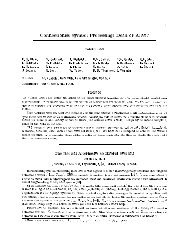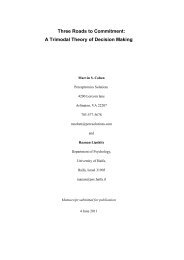Three Roads to Commitment: A Trimodal Theory of Decision Making
Three Roads to Commitment: A Trimodal Theory of Decision Making
Three Roads to Commitment: A Trimodal Theory of Decision Making
You also want an ePaper? Increase the reach of your titles
YUMPU automatically turns print PDFs into web optimized ePapers that Google loves.
<strong>Three</strong> <strong>Roads</strong> <strong>to</strong> <strong>Commitment</strong>: A <strong>Trimodal</strong> <strong>Theory</strong> <strong>of</strong> <strong>Decision</strong> <strong>Making</strong> 15<br />
matching generates action (including plans, tactics, and values) in the absence <strong>of</strong> commitment at desired levels <strong>of</strong><br />
specificity and scope. Matching is fundamental, then, both because the other two modes are practices that must fit a<br />
particular situation while continued matching is the default, and because matching is the only non-random source <strong>of</strong><br />
the raw material for their operation. The alternative in both cases is relatively unguided, i.e., “random,” search.<br />
The priority <strong>of</strong> matching in these two senses does not mean that matching is or should be the initial “phase” in<br />
every episode <strong>of</strong> decision making. First, that would diminish, not enhance matching’s role. The contribution <strong>of</strong><br />
matching is accumulated over lengthy stretches <strong>of</strong> cultural and individual his<strong>to</strong>ry; it cannot be squeezed in<strong>to</strong> a<br />
“phase” <strong>of</strong> decision making. Choice and reassessment are the visible tip <strong>of</strong> an iceberg while matching is its far vaster<br />
submerged body. Second, explicit decision making is always in media res: <strong>Decision</strong> makers may therefore find<br />
themselves with a commitment they need <strong>to</strong> reassess, or with a set <strong>of</strong> options from which they need <strong>to</strong> select, in<br />
environments that license the practice. Unless there is specific reason <strong>to</strong> reassess more fundamental assumptions<br />
(e.g., about the situation, goals, or permitted practices), they need not be concerned with where the initial<br />
commitments came from. While matching is “prior” in some respects, there is no a priori sequence <strong>of</strong> modes that<br />
applies <strong>to</strong> every decision problem, either descriptively or prescriptively.<br />
The Flexibility <strong>of</strong> Reassessment<br />
Reassessment and matching are deeply complementary. While matching seeks <strong>to</strong> maximize the number <strong>of</strong><br />
truths, reassessment seeks <strong>to</strong> minimize the number <strong>of</strong> errors. Thus, matching seals commitments and reassessment<br />
unlocks them. Matching, if taken by itself, assumes that personal and collective experiences embodied in rules are<br />
sufficient for the problem at hand. Reassessment assumes the possibility <strong>of</strong> mistakes and stands ready <strong>to</strong> learn from<br />
them. The rules and practices that underlie matching have largely evolved through the kind <strong>of</strong> trial and error<br />
involved in reassessment – whether biological, cultural, organizational, or individual – rather than by the deliberate<br />
comparison and calculation <strong>of</strong> benefits exemplified in choice (Smith, 2008). Matching and reassessment are both<br />
necessary: one <strong>to</strong> generate commitments based on accumulated knowledge and the other <strong>to</strong> vett commitments and<br />
stimulate improvements, which are then used in future matching.<br />
The more connected a commitment is <strong>to</strong> other commitments, the more resistant it is <strong>to</strong> reassessment. Regardless<br />
<strong>of</strong> its origins, an intention becomes more central through continued successful use in the background <strong>of</strong> decision<br />
making, resulting in an expanding web <strong>of</strong> connections <strong>to</strong> the new goals, plans, and tactics that it has helped <strong>to</strong><br />
generate, as well as <strong>to</strong> other goals, plans, tactics, and beliefs that combined with it <strong>to</strong> do so. As centrality increases<br />
through use, resistance <strong>to</strong> reassessment must also grow, due <strong>to</strong> the psychological, social or physical effort required




